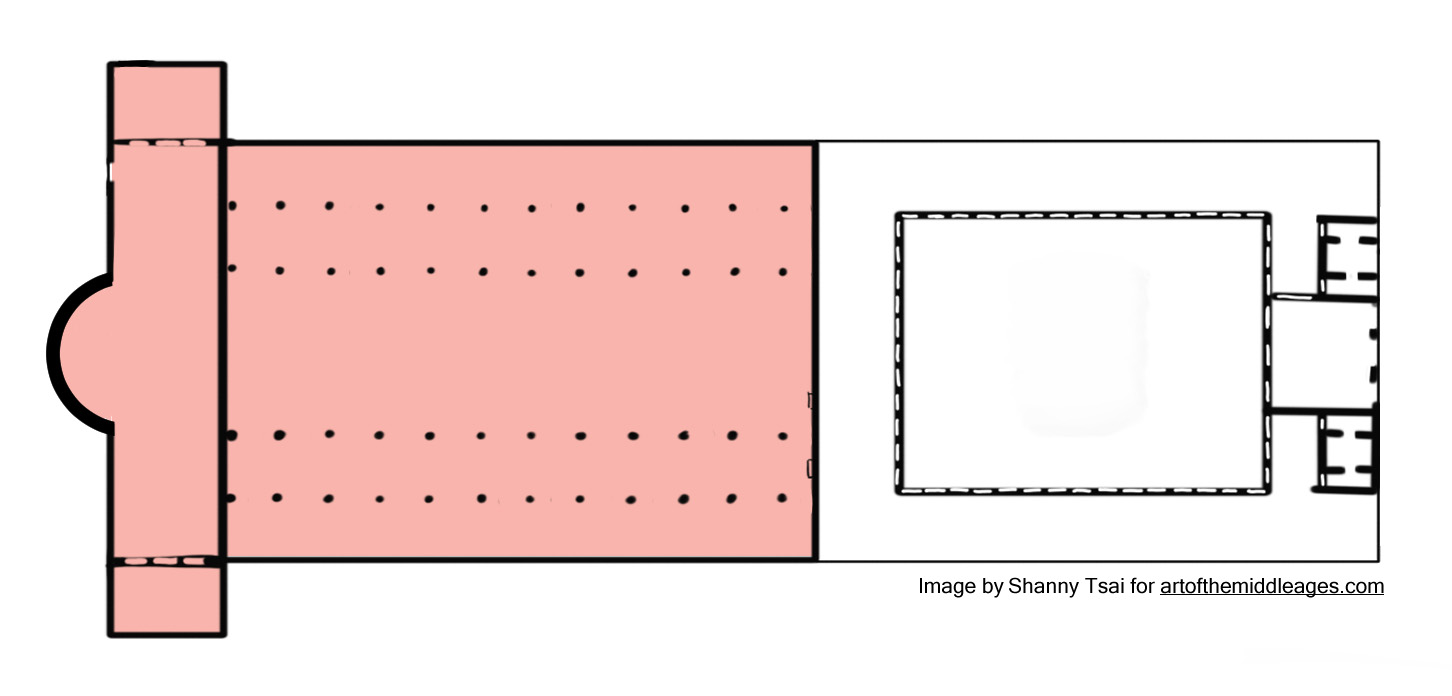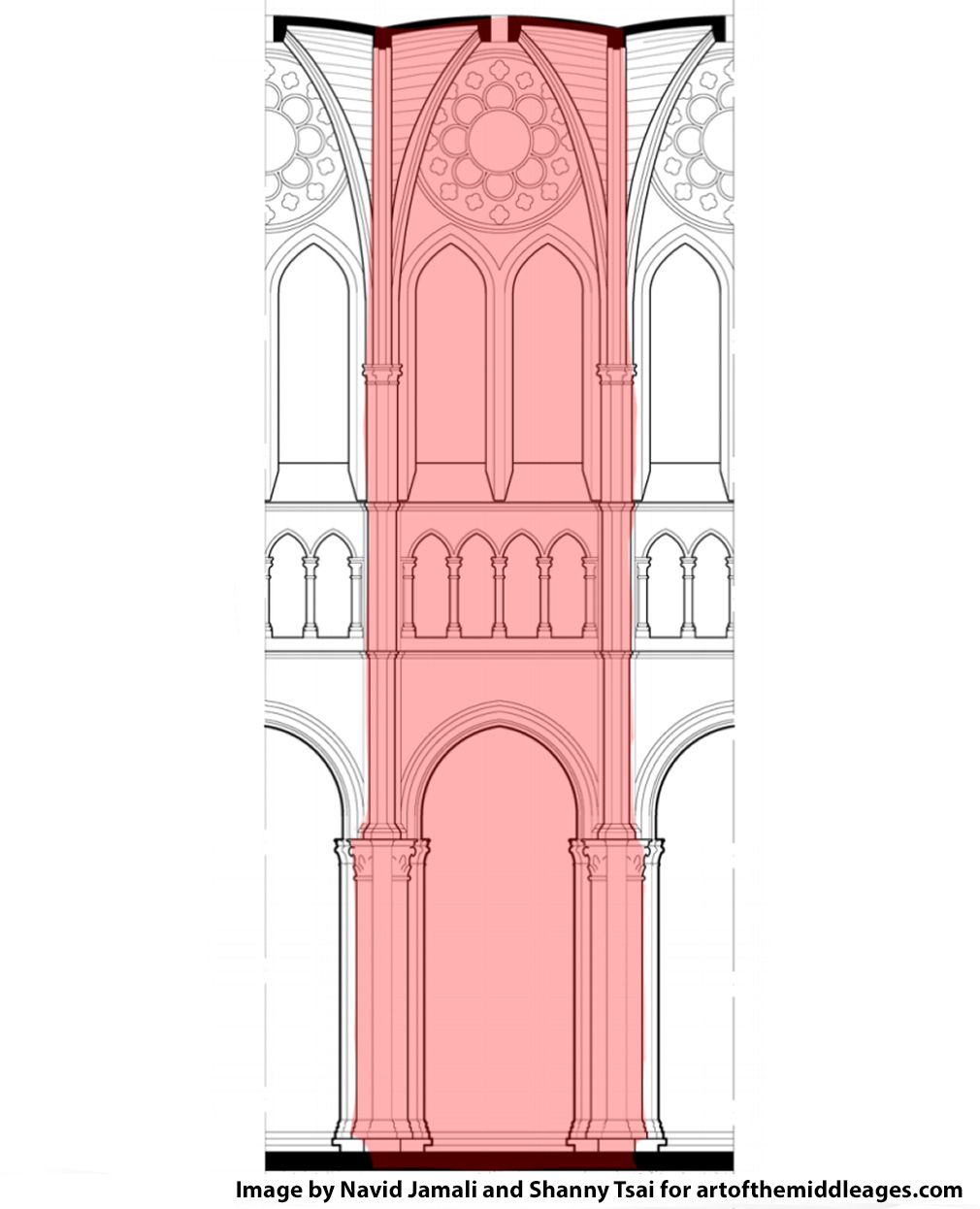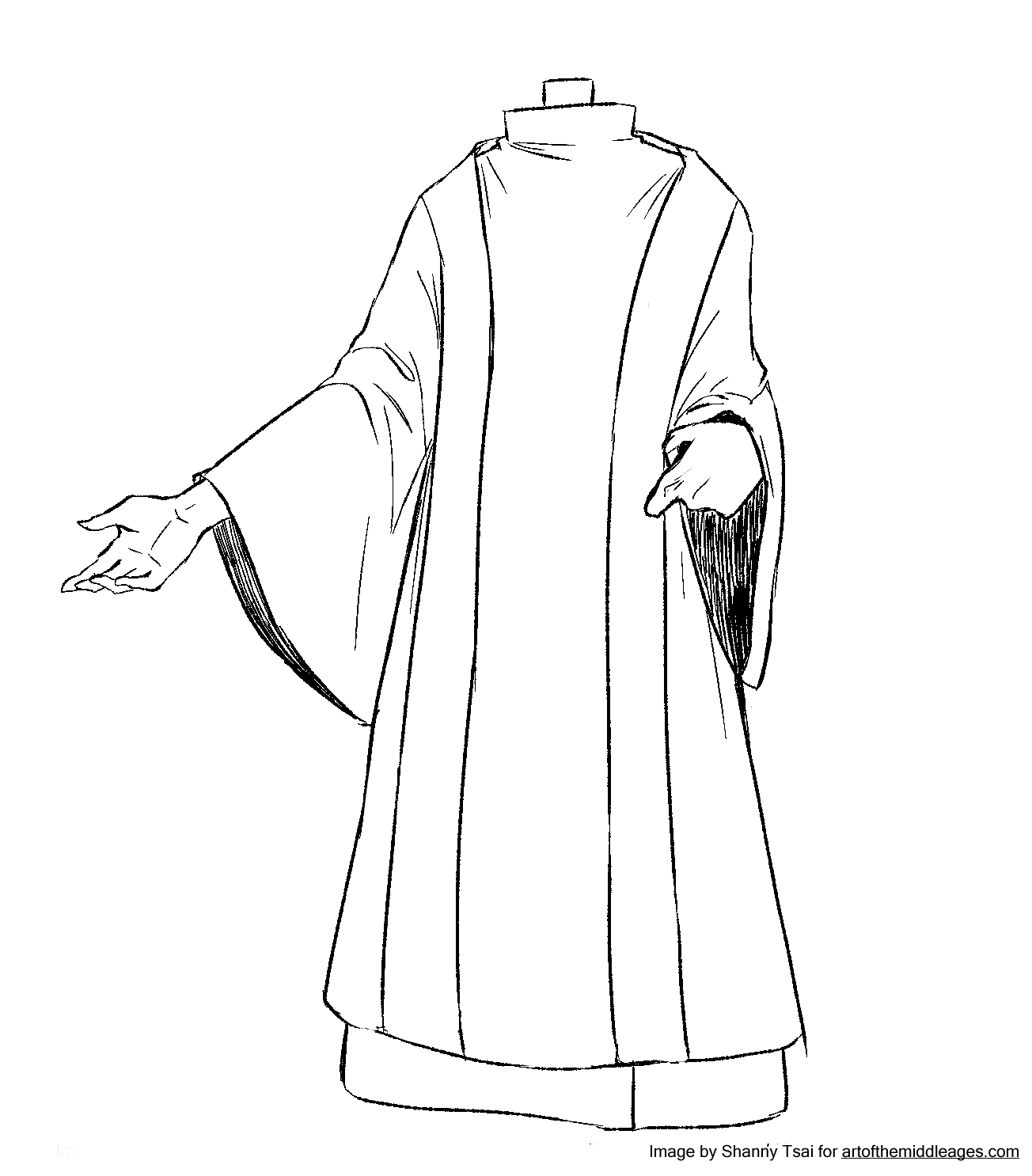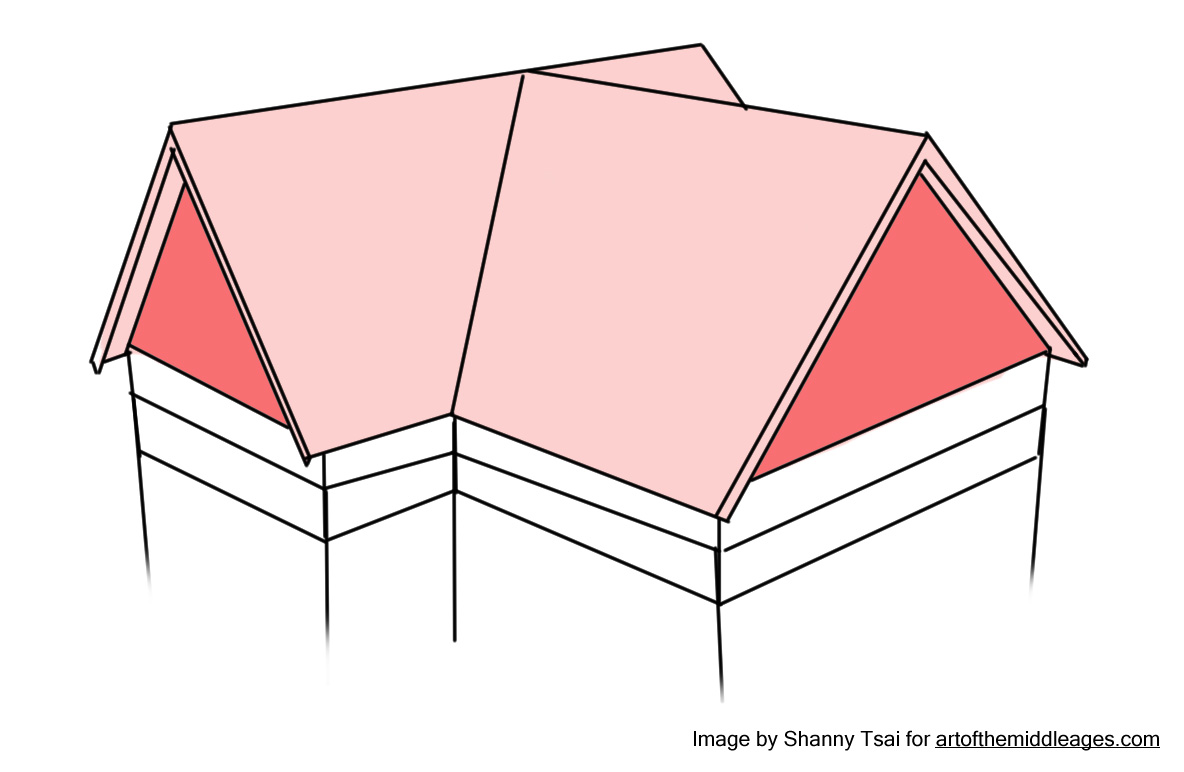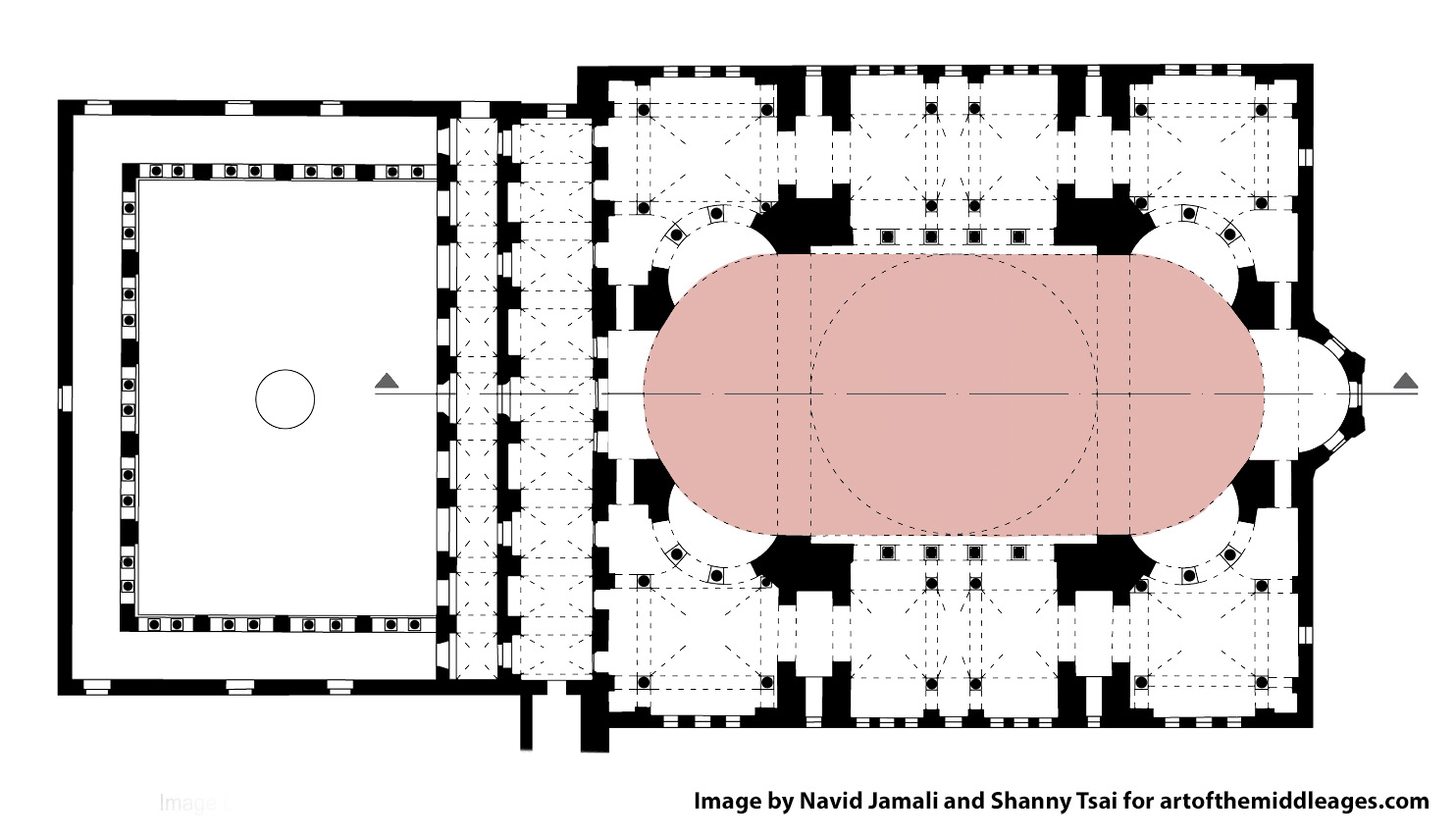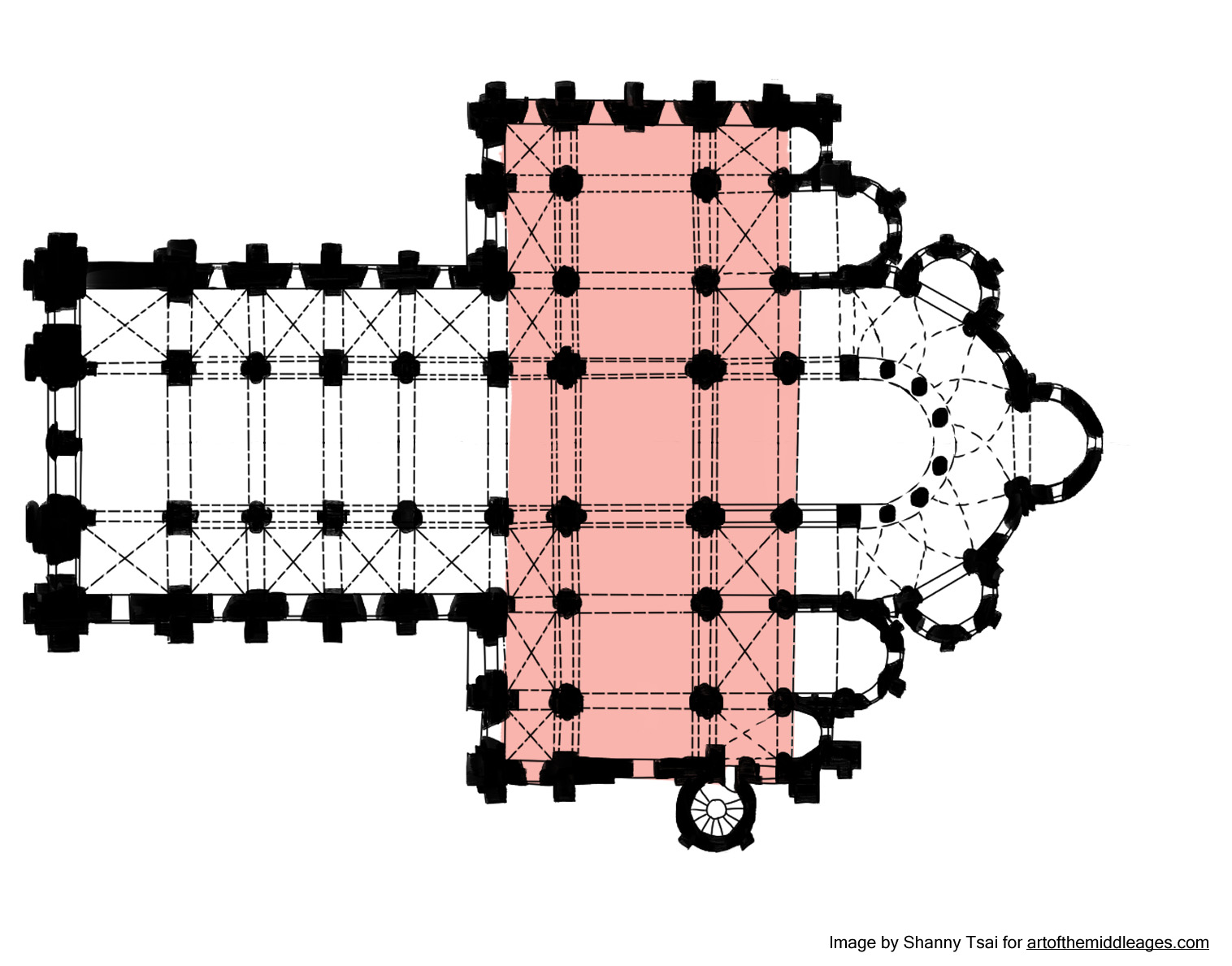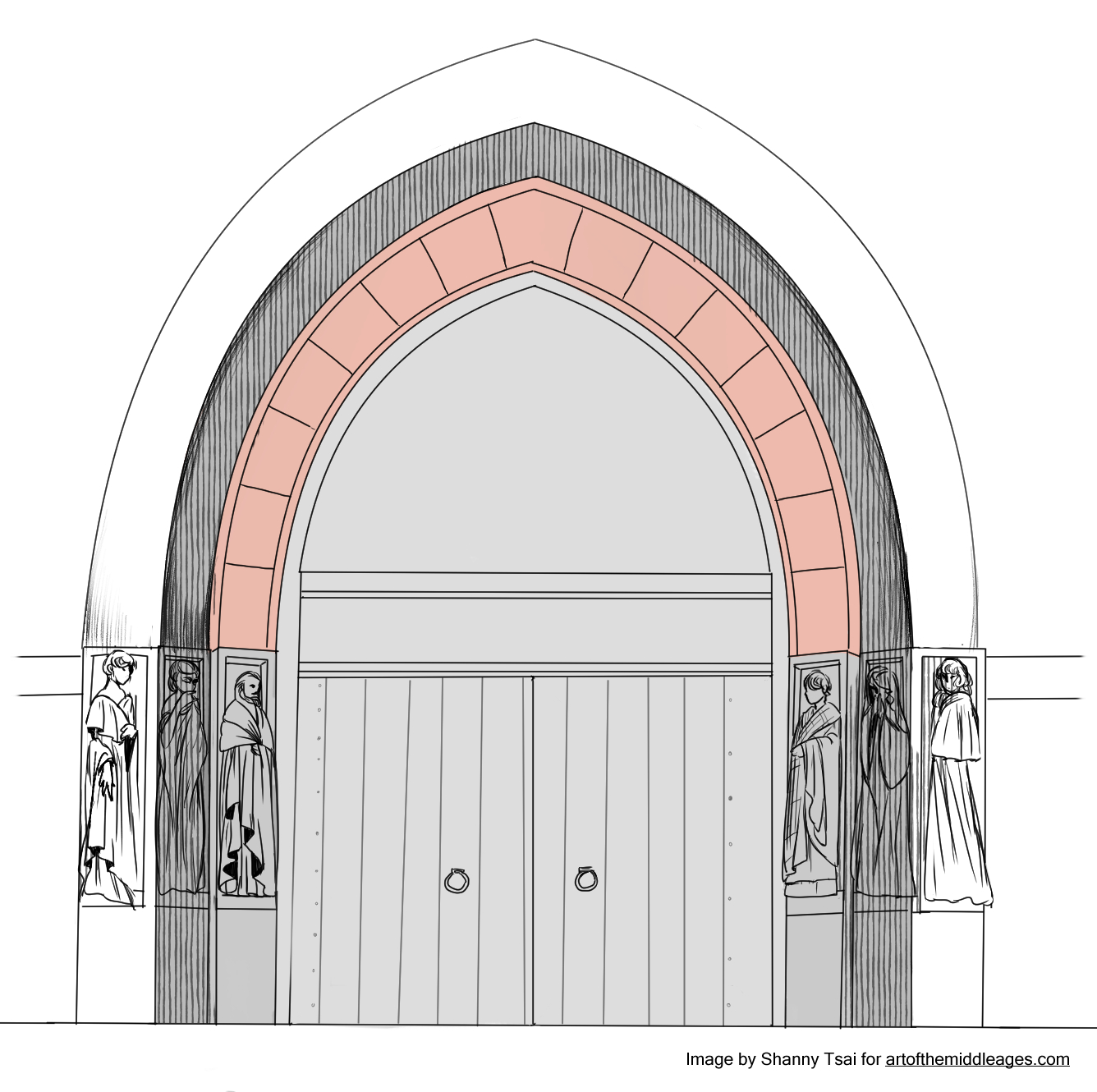Glossary
Words can have multiple meanings; the definitions in this Glossary correspond to the meanings in Art and Architecture of the Middle Ages: Exploring a Connected World (Cornell University Press, 2022).
A B C D E F G H I J K L M N O P Q R S T U V W X Y Z
A
abbey: Roman-rite monastery ruled by an abbot or abbess
acanthus: Mediterranean plant whose leaves were imitated in ancient and medieval sculpture
aedicula: small niche or shrine
aër: veil that covered the bread and wine as it was brought to the altar during the Orthodox Eucharist
Agnus Dei: Latin for "Lamb of God," a Christian iconographic motif based on John 1:29
al-Andalus: Arabic name for the Iberian Peninsula, parts of which were under Muslim control from 711 to 1492
alfiz: rectangular panel that frames an arch, usually the upper, rounded part
alloy: two or more metals that fuse together when heated
altar: elevated block or table on which religious ceremonies are performed; in the Jewish Temple, used for animal sacrifices and other offerings to God; in Christian churches, used for consecration of the eucharistic elements
altarpiece: object atop or behind a Christian altar, usually painted or carved with images of the altar's dedicatee
Amazigh, pl. Imazighen: Berbers, the Indigenous peoples of North Africa and the Sahara
ambulatory: aisle to facilitate circulation, especially one that curves around the east end of a church
ampulla: small portable flask to hold sanctified liquid, often decorated
amulet: protective device, often worn on the body
anagogical: rising upward, toward heaven
Anastasis: Greek for resurrection; the rotunda over the tomb of Christ in Jerusalem, and the Byzantine scene of Christ descending to Hades to retrieve such pre-Christian figures as Adam, Eve, John the Baptist
aniconism: tendency to avoid or opposition to representational imagery
annular: ring-shaped, like a semicircular crypt
antemihrab dome: dome in front of the mihrab in a mosque
apocryphal: religious texts not considered canonical by some, but often widely read
apostates: people who abandon a faith
apotropaic: referring to a protective device that turns away envy or evil; apotropaia is the collective plural for such devices
apse: vaulted semicircular space, often in the end wall of a longitudinal church
arabesques: continuously repeating, abstract vegetal or geometric designs
arca: Latin for box for valuables, such as the Ark of the Covenant
arcade: row of arches carried on columns, piers, or pilasters
archbishop: bishop who heads a Christian ecclesiastical province that contains multiple bishops
architrave: horizontal beam
archivolt: projecting band or molding that surrounds an arched opening; often carved
arcosolium: arched niche in a wall, often for burial
ascetic: strict, self-denying religious practice; or a person who practices asceticism
ashlar: precisely cut stone masonry
atrium: unroofed courtyard in front of a house or public building
axonometric: architectural drawing in which a building is rotated to show multiple sides
B
baldachin: canopy, freestanding or attached to a wall, often above an altar or tomb
banna'i: Persian for builder's technique; architectural decoration in which plain bricks alternate with glazed ones to represent sacred names or pious phrases
bar tracery: thin stone bars that divide sections of a stained-glass window
barrel vault: continuous semicircular, tunnel-like vault
basilica: longitudinal building, often with a wider, taller central nave and narrower, lower flanking aisles; adopted for Christian religious use from Roman civic architecture
basmala: Arabic acronym, from "In the name of God, the merciful, the compassionate," which is the most common expression of Muslim piety and appears at the beginning of all but one chapter of the Qur'an
bay: unit of a building defined by vertical supports, such as two piers or columns, including the vaults above that space
bema: sanctuary area of a synagogue or church
Berbers: Imazighen, the indigenous peoples of North Africa and the Sahara
bestiary: moralizing treatise about animals
bezel: top of a ring, attached to the hoop, with images, stones, or other decoration
Bible, biblical: collection of sacred texts, generally referring to those of Jews (Hebrew Bible) and Christians (Old and New Testaments); and the contents, characters, or time of the Bible
bifolium: one sheet of parchment or paper folded to make two leaves in a manuscript
bilateral: two-sided
bishop: Christian clergyman, ranking higher than a priest, who heads a bishopric or diocese
blind arch: filled-in arch
blood libel: false charge that Jews murdered a Christian for ritual purposes
bracteate: thin precious-metal plaque stamped on one side with a die
brass: alloy of copper with zinc, tin, or other metal, which makes the product stronger than copper
bronze: alloy of copper with tin and sometimes a small amount of another metal, making the product stronger than copper or brass
bronze casting: method of producing bronze objects or sculptures in a mold
buttress: projecting mass of masonry perpendicular to the exterior of a building that supports it at points of stress
C
caliph: Arabic for a successor of Muhammad, leader of the Muslim community
caliphate: political-religious state ruled by a caliph
calligraphy: from Greek for beautiful writing, as in a manuscript
Calvary: place outside Jerusalem where Jesus was crucified, known as Golgotha in Aramaic, enshrined within the Holy Sepulcher complex; also, the group of Jesus on the cross flanked by Mary and the apostle/evangelist John
cameo: small relief sculpture made by carving into a gem or stone that has layers of different colors
campanile: Italian for bell tower
canon, canonical: a collection of authoritative works or texts; also, part of the Christian eucharistic liturgy
canon tables: concordance of the four Gospels showing shared passages, systematized by Eusebius in the fourth century; often decorated
canonize: declare a deceased person a saint, or elevate a work or text to canonical status
capital: architectural element that crowns a pier or column and separates it from what it supports; often carved
caravanserai: Persian for roadside lodging for travelers and merchants
carbon-14: a radioactive isotope of carbon; when organic material (wood, fiber, bone, etc.) dies, it stops absorbing carbon and the isotope decays at a known rate, making it datable
carpet page: page in a manuscript that resembles a carpet because it is covered with symmetrical and usually nonfigural ornament
cartoons: full-size preparatory drawings, used to transfer a design to a surface
casket: box or chest, often portable
catacomb: underground cemetery with multiple narrow passages that open into rooms
cathedral: church that contains a cathedra; the main church of a bishopric or diocese
Catholic: Greek for universal, as in the early undivided Christian Church; more narrowly, the Roman-rite Church (versus Orthodox) and its liturgical system and doctrines
cenobitic: type of monasticism in which monks live together in communities
cenotaph: tomb or a funerary monument that does not contain a body
censer: vessel for burning incense, usually made of metal
centaur: composite creature from Greek myth, half man and half horse
chahar taq: Persian for four arches; the traditional form of a Zoroastrian fire temple, with four arches or short barrel vaults between four corner piers that support a dome; adopted in Islamicate architecture
Chalcedonian: Christians who accept the decisions about the nature of Christ promulgated by the Fourth Ecumenical Council, held at Chalcedon (now Kadiköy, Turkey) in 451
chalice: cup or goblet used in the Christian mass
chamberlain: chief officer in a household or palace
champlevé: technique for making enamels, in which a metal ground is cut out and the resulting space filled with glass that is then fired
chancel screen: low barrier, often of stone, that separates a church sanctuary (chancel) from the naos or nave; also called the templon
chapter house: room or building where a group of monastics or clergy meets for readings or business
chasing: ornamentation made by a hammer and tools on the front of a metal object
chasuble: wide sleeveless mantle worn to perform a mass in the Latin-rite church
chevet: east end of a Roman-rite basilica, including the choir, apse, ambulatory, and radiating chapels
chip-carving: hand carving by removing small chips, and the decoration that results
chi-rho: superimposed X-P monogram, the first two letters of Christos, Greek for Christ (Messiah)
choir: space in a Roman-rite church between the sanctuary and the nave, generally used by monks and clergy who sing during services
choros: circular chandelier in an Orthodox church
Christogram: see chi-rho
ciborium: roofed structure over an altar
circumambulate: walk around something, such as a shrine or worship space, usually in a ritualized way
citadel: fortress with residential and military functions
clerestory: window zone of a wall
clerical: relating to the clergy
clipeus, pl. clipeae: in antiquity, a round shield; a circular frame that encloses figural or other decoration
cloisonné: metalwork technique in which thin gold strips are attached at right angles to a base; the resulting cells are then filled with glass or gems
cloister: unroofed multipurpose space in a monastery or cathedral, enclosed by roofed walkways, usually connecting the south side of the church with other buildings
codex: book composed of folded sheets, often sewn or bound together on one edge
colonnade: a series of columns that supports a straight entablature
colophon: text, often at the end of a manuscript, that contains information about its production
commune: medieval Italian city-state
compound pier: vertical support composed of multiple shafts around a central core
confraternity: group of laypeople with a common religious or charitable goal
convent: complex built for religious seclusion of celibate monastics, usually nuns
cope: long semicircular cloak worn by Latin-rite clergy for other liturgical activities, not for mass
Coptic: belonging to the Miaphysite (non-Chalcedonian) Christian Church in Egypt as it developed under Muslim rule, especially after the ninth century; or the language used by Christians in Egypt, the last phase of Egyptian
corbel: masonry block or bracket that projects from a wall, sometimes carved
corbel frieze, corbel table: continuous decorative arcade supported by corbels, often near a roofline
cosmological: pertaining to the cosmos, or the ordered universe
cramps: staple-like fasteners that connect masonry blocks
crenellated, crenellation: projecting rectangular pattern at the top of a wall, usually used for defense
crockets, crocketed: small hook- or leaf-shaped carvings along the upper edges of late medieval European buildings, imitated in smaller-scale works
crossing: space where the nave, transept, and choir of a church intersect
cross-in-square: typical middle Byzantine centralized church plan with nine bays, in which four columns or piers define a cross shape and support a central dome braced by tall vaulted cross arms; the lower corner spaces are also vaulted
cross-nimbus: circular halo of light with a cross that identifies Christ
crypt: vaulted space in a church, often for tombs or relics, usually under the main story
cubit: ancient unit of measurement based on the length of an adult man's arm from the elbow to the tip of the middle finger
cult: system of religious beliefs and rituals associated with worship
cusp, cusped: intersection of two arcs or foils
D
dado: lowest zone of a wall, often given distinctive decoration
dalmatic: loose clerical garment with long sleeves
daughter house: monastery dependent on the motherhouse of a religious community
deacon: Christian clergy below the rank of priest
Deesis: Greek for petition; Byzantine depiction of Christ flanked by Mary and a saint, usually John the Baptist, who are witnesses to Christ's divinity and intercede with him on humans' behalf
dendrochronology, dendrochronological: method of dating wood by studying tree rings, which share growth patterns across a wide geographical area
despot: from the Greek for master or lord of a despotate (polity)
dhimmi: Jews and Christians in Islamicate lands, given protected status as fellow People of the Book
diaper: repeated pattern, often lozenge-shaped (diamond-shaped), that forms a background
dinar: Islamicate gold coin, originally the same size and weight as the Byzantine nomisma
diptych: two panels, of any material, hinged together; originally filled with wax as a writing surface
dirham: Islamicate silver coin
doctrine: something taught as true and supported by authorities
dogtooth: small ornamental pattern of projecting triangles
domed-octagon plan: Byzantine centralized church plan in which eight piers or columns that define the naos support a dome
donjon: principal towerlike stronghold of a castle, also used as a residence; synonymous with keep
drum: cylindrical or polygonal structure that supports a dome; or a cylindrical block, one of several that compose a column
dualist: faith that believes the universe is dominated by two opposing principles, dark and light or bad and good
E
Eastern Orthodox: Churches under the patriarchate of Constantinople, regardless of liturgical language, including such autonomous Churches as Greek Orthodox and Russian Orthodox
ecumenical: from the Greek word for the inhabited world used to describe Church councils that drew bishops and others from across the Christian world
effigy: any likeness or image of a person, but especially the full-body sculpture of the deceased on a tomb
elevation: side view of an architectural structure or its projection onto a vertical plane
émail brun: French for brown enamel, a method of lacquering a metal surface with linseed oil to turn it brown when heated; often gilded
embroidery: works, usually textile, decorated with stitched designs made of thread or fine wire
emir: Arabic for commander, leader of an emirate (province)
enamel: powdered glass and pigment, melted and fused to a metal, glass, or ceramic support
encaustic: painting technique in which pigments are mixed with melted wax and applied in layers
entablature: parts of a wall supported by columns
epigram: concise poem
epigraphy, epigraphic: monumental inscriptions, in any medium
episcopal: from the Greek for overseer; relating to bishops, who oversee Christian practice
epitaphios, pl. epitaphioi: Greek for on the tomb; large textile depicting the dead Christ used in Orthodox churches
epithets: descriptive names or titles for an individual
eremitic: ascetic practice of living alone, like a hermit, and a type of monasticism that emphasizes solitary life
Eucharist: from the Greek for giving thanks; the consumption of bread and wine representing the body and blood of Christ, the most important Christian liturgical activity
ewer: tall vessel for liquids with a pouring lip and handle
extramission: ancient and medieval theory that visual perception results from beams emitted by the eyes
eyvan: Persian for iwan, a barrel-vaulted space open on one side
F
facture: process or manner in which something is made, including its materials
feast: Christian holy day, usually associated with an event or saint
fibula, pl. fibulae: large pin to fasten a garment, often ornamented
filigree: jewelry technique using gold or silver wires
findspot: place where an object has been found, rather than where it was produced
finials: ornaments at the end of a spire or other vertical feature
fleur-de-lys: stylized iris, the royal emblem of France
flourisher: in a manuscript workshop, one who provides decorative flourishes
flutes: shallow vertical grooves on a column
flying buttress: buttress with arches that extend through the air to strengthen points of stress on exterior walls
foliate: leafy decoration
foliated Kufic: type of angular Arabic script in which the ends of some letters take on floral or leafy forms
folio: page or leaf of a manuscript (abbreviated as fol.)
font: basin used for Christian baptism
form, formal: basic shapes, designs, and components, such as lines, colors, volumes; and artistic concepts associated with form rather than with content
fresco: painting on wet plaster, so that pigments adhere firmly
Friday mosque: masjid al-jami', congregational mosque in which a sermon is delivered on Fridays to the local Muslim community
fritware: ceramic technique, using a body of ground quartz, clay, and ground glass; yields a firmer, whiter body than stoneware
frontal: carved, painted, or textile panel displayed in front of a Christian altar
G
gable: roof with two sloping sides that meet at a ridge, or the triangle at the end of a roof
gargoyle: projecting waterspout carved in the form of an open-mouthed creature
geniza: storeroom in which pages that refer to God are discarded rather than destroyed; often associated with a synagogue
gesso: preparatory layer for painting, made of animal glue, chalk, and pigment
gilt-silver: gold applied to a silver object
glacis: smooth, stone-lined slope used for defense
glaze, glazed: thin, opaque coating applied to ceramics after initial firing, then refired at a lower temperature to vitrify it; and the product that results
granulation: tiny grains or balls of precious metal applied to a metal base
grave goods: objects, often of value, deliberately deposited in or near a grave
griffin: mythical composite creature with the head and wings of an eagle and body of a lion
grisaille: painting in monochrome, usually gray
groin vault: four-part vault formed by the intersection of two barrel vaults
H
habit: everyday clothing worn by a monk, nun, or priest
hadith: sayings of Muhammad and, in Shi'i Islam, the traditions of the imams
hagiography, hagiographic: idealizing biography (vita) of a saint
hajib: chamberlain, a high administrative position in an Islamic court
hajj: annual pilgrimage to Mecca and Medina, required of all Muslims
hamdala: Arabic phrase, "Allah (God) be praised! Praise be to Allah! There is no god but Allah!"
headpiece: ornamented panel or frame that marks the beginning of a text in a manuscript
Hetoimasia: Greek for preparation; in iconography, the empty throne prepared for Christ's Second Coming
hijra: Arabic for emigration or flight, specifically Muhammad's journey from Mecca to Medina in 622 CE, the beginning of the Muslim calendar
hippodrome: racetrack for chariots or horse racing
historiated: decorated with identifiable scenes or figures, such as a manuscript initial or a capital
historiated initials: initial letter on a manuscript page with identifiable scenes or figures
hoard: deliberately hidden group of objects
Hodegetria: Greek for She Who Points the Way; an important icon of Mary in Constantinople and its copies
hypostyle: from the Greek for many rows of columns, supporting a roof
I
icon: Greek for image, not restricted by medium or size but often painted on a wooden panel; depiction of a holy figure or sacred event used to inspire devotion to the prototype
iconoclasm: image-breaking; period in which figural images were destroyed, including, in the Byzantine world, 726–87 and 815–43
iconoclast: one who destroys images, or a supporter of such destruction
iconography: subject matter and meanings of an artistic representation
iconophile: lover of images; a supporter of icons, who believes that prohibiting the making of images of Christ denies his human incarnation
iconophobia: fear of images
iconostasis: tall chancel screen in late and post-Byzantine churches, filled with icons
imam: Muslim spiritual or prayer leader; also a descendant of 'Ali and leader of a Shi'i community
imitatio Christi: Latin for imitation of Christ
impost: architectural element inserted between a capital and what it supports
incipit: opening words of a text in a book
incubation: practice of sleeping in a sacred space, in hope of a divinely inspired dream or cure
intaglio: sculptural technique in which a design is sunk into the surface by carving or incising
investiture: ceremonial conferring of symbols of office, especially robes (vestments)
Islamicate: art in regions in which Muslims are culturally dominant, but not necessarily religious art
itinerant: traveling, like some artists and courts
iwan: Arabic for a large barrel-vaulted space with walls on three sides
J
jamb figures: statues flanking a doorway, often attached to a column or wall
joggled voussoirs: masonry units that interlock, like puzzle pieces, to form an arch
K
Ka'ba: Arabic for cube; building in Mecca, focus of the hajj
Karaite: medieval Jewish movement that emerged in the ninth century in western Asia; its followers accept the Hebrew Bible and reject the oral laws of the rabbis and the Talmuds
katholikon: main church of an Orthodox monastery
keep: principal stronghold of a castle, also used as a residence; synonymous with donjon
kermes: red dye obtained from an insect that lives in oak trees near the Mediterranean
khagan, khaganate; or khan, khanate: Turkic titles for the chieftain of a territory in the Eurasian steppes, or the names for such a territory; among the Mongols, a khagan was superior to a khan
khanaqah: Sufi lodge
khatchkar: Armenian for cross-stone, a stone slab carved with a cross
khurus: tall transverse space, marked by a wall, between the nave and sanctuary of a Coptic (Egyptian Christian) church
kitabkhana: Arabic for scriptorium; from kitab, book
koimesis: Greek for sleep, the Byzantine name for the Dormition and assumption to heaven of Mary's body; feast day celebrated on 15 August
Kufic: angular Arabic script with clear vertical and horizontal lines
kumbl: Scandinavian burial monument
L
lancet: tall, pointed arch or window
lapis lazuli: blue semiprecious stone, mined in Afghanistan
late antique, late antiquity: the period of Roman imperial decline and its aftermath, roughly between the third and seventh centuries CE
late Byzantine: period of Byzantine history from 1204 (Latin conquest of Constantinople) or 1261 (Byzantine recovery of Constantinople) to 1453 (Ottoman conquest of Constantinople)
latten: gold-colored alloy of copper, zinc, tin, and sometimes lead
leadpoint: pencil-like tool of lead; or the drawings made from this tool
lectionary: book with biblical extracts arranged in calendar order for reading aloud in church
lintel: horizontal element that spans a door, window, or other opening
liturgy, liturgical: from the Greek for public duty; the collection of rituals, especially prayer services, prescribed for worship; or things connected to a liturgy, such as vestments or icons
loros: long, gem-encrusted scarf worn over a tunic by emperors and archangels
lost-wax method: casting technique, usually for a sculpture, in which a wax mold is covered with plaster; after the wax is melted away, molten metal is poured into the plaster cast to produce the desired sculptural form, revealed after the outer mold is broken
lunette: half-moon shape, such as one framed by archivolts over a doorway
lusterware: ceramic technique in which metallic oxide is applied over opaque white glaze, then refired
Luther, Lutheran: Martin Luther (1483–1546), and followers of the oldest Protestant denomination, which emerged from Luther's Reformation of the Catholic Church in Germany, then Scandinavia and elsewhere in Europe; emphasizes scripture rather than Church authorities and recognizes sacraments of baptism, Eucharist, and penance
M
madrasa: Islamic educational institution, especially for religious studies
Maiestas Domini: Latin for Majesty of the Lord, iconography in which a blessing Christ is enthroned in a mandorla
mandorla: area of light, often oval or almond-shaped, that surrounds the representation of a holy person (usually Christ) as an indication of sanctity
mappa mundi: Latin for world map
maqsura: screened area near a mosque mihrab that creates a private prayer space
Marian: having to do with Mary, the mother of Jesus
marginalia: figures or scenes on the edge of a page, object, or building
martyrium: shrine built in memory of a martyr
martyrology: catalog or account of Christian saints and martyrs who were included in an institution's prayers
masjid al-jami': congregational or Friday mosque, in which a sermon is delivered on Fridays to the local community
masonry: building material made of cut or carved pieces of stone or brick
matrix, pl. matrices: mold(s) for making a seal or other small object
meander: continuous ornamental pattern of angular or curved lines, named for the twisting Meander River (Turkey)
Melkites: Orthodox, Chalcedonian Christians in the eastern Mediterranean area who used Arabic as their language of worship
mendicant: someone who begs, of any faith, including a member of one of the religious orders dependent on charity that emerged in Europe in the thirteenth century
menologion: collection of Orthodox saints' lives (vitae) arranged according to their commemoration in the church calendar
menorah: stand holding oil lamps, the principal symbol of Jewish faith in the Middle Ages
mercantile: related to merchants or trade
metrical: text or inscription composed in poetic meter
metropolitan: archbishop who oversees an ecclesiastical province
Miaphysite: Greek for one nature; member of one of several Oriental Orthodox Churches who opposed the wording of the Council of Chalcedon about the dual natures of Christ and argued instead that Jesus is fully human and fully divine in one nature
micrography: tiny writing, especially Hebrew, often in decorative form
middle Byzantine: period of Byzantine history from the eighth or ninth century until 1204 (Latin conquest of Constantinople) or 1261 (Byzantine recovery of Constantinople)
midrash: ancient or early medieval commentary on Jewish Scripture
mihrab: arched niche in the qibla wall of a mosque that indicates the direction of prayer, toward Mecca
mikvah, pl. mikvaot: underground bathing pool used for Jewish purification rituals
millefiori: Italian for thousand flowers; colored glass tubes sliced and embedded in clear glass to form patterns
mina'i: Persian for enameled ware, twice-fired fritware ceramics produced in Seljuq Iran with some colors are under the glaze and others over; also called haft rang (seven colors)
minaret: tower, usually of a mosque
minbar: elevated pulpit in a mosque, with stairs leading to a platform from which sermons are delivered
minuscule: small script, widely used in medieval books
mirador: Spanish for a balcony or window that provides a scenic view
monastery: complex built for religious seclusion of celibate monks or nuns
monotheist: belief in or worship of one God
mortar: material used for binding brick or masonry construction, usually a mix of lime (a calcium compound) or plaster, sand, and water
mosaic: decorative technique for walls or floors that uses small tesserae to create images or patterns
motherhouse: main monastery of a religious community on which other monasteries depend
muqarnas: Islamicate decorative vaulting system based on repeating tiers of small nichelike elements that resemble honeycombs or stalactites (e.g., the ceiling of the Cappella Palatina)
myron: Greek for oil or unguent with miraculous healing properties, emitted by the body of some saints
N
naos: main worship space in a Byzantine centrally planned church, including the area under the dome but excluding the sanctuary
narthex: vestibule that precedes the entrance into the main space of a church, often extending the width of the facade
nave: central aisle of a longitudinal building, often wider and taller than the side aisles from which it is separated by columns or piers
necropolis: Greek for city of the dead, a large cemetery
Neoplatonic: philosophical school that emerged in late antiquity, modifying Plato's teaching; Neoplatonists understood the world as an emanation from a single principle, the One, with whom the soul has the potential to reunite
Nestorians: followers of Nestorios, bishop of Constantinople (d. after 451), who distinguished two persons in Christ, the son of Mary and the son of God, and therefore denied that Mary was the mother of God (Theotokos)
niello: shiny, dark metal alloy used as inlay in precious metalwork
nimbus: halo around the head of a ruler (in Roman and Sasanian art) or holy person (in Christian and Islamic art)
nomisma, pl. nomismata: Byzantine gold coin, equivalent to the Roman solidus, pl. solidi
numismatic: relating to coins
O
offices: structured Christian services separate from the mass, often at fixed hours; the daily round of monastic observances
opening: in manuscripts, pages that face each other when a book is open
openwork: perforating a material with decorative intent, or a work made in this technique
opus sectile: slices of stone, often in different colors, inlaid in patterns on walls or floors
orant: ancient pose of prayer with hands upraised and elbows bent
Orthodox, Orthodoxy: Greek for right belief; correct doctrine and worship, and adherents of this who follow the Byzantine liturgy and doctrines
P
palmette: motif of radiating palm leaves
Panagia: Greek for All Holy,"referring to Mary
Pantokrator: Greek for Ruler of All; an image of Christ as a mature, bearded figure holding a Gospel book, often depicted in the dome of a Byzantine church
parchment: animal skin that has been scraped and dried to produce a writing surface
parekklesion: side chapel of a Byzantine church, often funerary
parish church: main church of the smallest Christian administrative unit
Passion: from the Latin for suffering, the period in the life of Jesus from his entry into Jerusalem through his crucifixion, sometimes including his resurrection and ascension
paten: plate to hold bread in the Christian mass
patriarch: the biblical Abraham, Isaac, and Jacob; or one of the most prominent Christian bishops, especially the archbishop of Constantinople, head of the Byzantine Orthodox Church
pectoral: object worn on the chest
pediment: triangular element in architecture, often over an opening
pendentive: curved triangle that makes a transition from a square base or bay to a circular dome
personification: an animal, inanimate object, or abstract idea given human characteristics
pier: vertical support in architecture, usually rectangular and of stone
pilaster: pier attached to a wall
pilgrim, pilgrimage: person who travels to a sacred place primarily for purposes of devotion, and devotional journeys
pinnacle: decorative vertical structure, often on buttresses or furnishings, that tapers to a spire
pishtaq: tall arch framing an iwan, or a monumental projecting portal in Islamicate architecture
plan: horizontal projection of an architectural structure or complex, as if seen from above
plaster: mix of water, lime, and sand, often bound with other materials, used to cover a wall
plate tracery: stone carved to accommodate glass, an early form of stained-glass window
polychromy: multiple colors
polykandelon, pl. polykandela: a metal lighting fixture that holds multiple glass oil lamps
polysemy, polysemic: having multiple meanings
polytheism: belief in or worship of multiple gods
pope: bishop of Rome, head of the Roman-rite or Catholic Church
porphyry: hard purplish stone quarried in Egypt, originally reserved for imperial use
portico: roofed space open on one side
portolan: chart used for maritime navigation
prependoulia: ornaments, usually pearls, suspended from a Byzantine crown to frame the face
presbytery: area around the main altar of a church, normally reserved for the clergy
proskynesis: act of bowing or prostrating oneself before a ruler or holy figure
prototype: original on which something is modeled; in icon theory, the holy figure "behind" the artistic representation
psalms: songs recited in Jewish and Christian worship, traditionally attributed to King David; collected in the Psalter
punching: decorating a surface with a pattern of small depressions made with a punch (tool)
putti: Italian for nude, male, winged toddlers derived from personifications of Cupid
pyx, pl. pyxes: small container, especially one that holds bread in the Christian mass
Q
qibla: the direction of prayer for Muslims, toward the Ka'ba
R
rabbinic: having to do with rabbis, teachers who made Jewish legal rulings after the destruction of the Temple in 70 CE led to the disappearance of Temple priests
radiating chapels: spaces that project from the apse or ambulatory of a church
radiocarbon: see carbon-14
recto: the front of a manuscript page or leaf, abbreviated as r; in Latin and Romance-language manuscripts, it is on the right of a two-page opening, but in Hebrew, Arabic, and Persian manuscripts, in which the text is read from right to left, it is on the left
refectory: dining hall in a monastery or other religious institution
relic: body part, clothing, or other object associated with a deceased holy person or in contact with one
relief: sculpture that projects from a background
reliquary: container to protect or display relics, in any medium
repoussé: metalwork technique that involves hammering from the reverse to create designs in relief
reredos: ornamental screen behind an altar, rising from ground level; it may be as wide as the nave and as tall as the vaults
retable: decorative panels or a shelf atop an altar or on a pedestal behind it
revetment: cladding or facing added to a surface
ribs: bands of protruding masonry that support a vault or dome
rib vault, ribbed vault: ceiling unit supported by a framework of protruding masonry that divides the vault into sections
rood screen: screen supporting a cross or crucifix; separates a Latin-rite church sanctuary from the nave
rosary: string of beads or knotted cord used to count prayers
rose window: large circular window filled with tracery and stained glass
rotunda: round building, usually covered by a dome
rubricator: from the Latin for red ocher, scribe who executes titles and chapter headings in red
rules, ruling, ruled: straight lines to guide the scribe writing a medieval manuscript
runes, runic: angular characters used in alphabets in medieval Scandinavia, Britain, and Mongolia
S
saga: narrative about heroic characters, primarily Scandinavian
samite: lustrous, heavy silk, made with a compound twill technique often using gold or silver thread
sarcophagus: Greek for flesh-eater; stone coffin used for burial, often carved
sardonyx: gem with translucent layers of sard (a mineral) and another mineral different in color
scribe: person who writes or copies a text by hand
scriptorium: room used for writing (and sometimes illustrating) books and documents; or a group of scribes and artists working together
scripture: body of religious writings considered authoritative or sacred
scroll: roll of flexible material used for writing and rolled up for storage
section: drawing that depicts a building as if cut vertically
sgraffito: Italian for scratched; ceramic in which the slip is scratched away to reveal the clay color underneath
shahada: profession of faith for Muslims, "There is no God but God, and Muhammad is his prophet [messenger]"
shahanshah: Persian for king of kings; emperor of an Iranian realm
Shahnameh (Arabic Shahnama): Persian for Book of Kings, the national epic poem written by Ferdowsi around 1000 but based on earlier legends
Silk Routes: network of overland and sea routes that linked China to western Asia, Byzantium, and Europe
side aisles: spaces flanking the central aisle of a longitudinal building, often separated by columns or piers
sinopia: dark red-brown pigment, made from iron oxide, used to make preparatory drawings for frescoes; the term is also used for the drawings
slip: watery clay, sometimes with additional materials, used to decorate ceramics
soffit: underside of a building part, such as an arch
spandrels: triangular wall surfaces above the springing of an arch
spolia: materials or artifacts taken and reused in a setting culturally or chronologically different from that of their creation
squinch: concave masonry sections, often arches, set across the corners of a square bay to make the transition to a circular dome
stained glass: molten glass to which metallic oxides are added to produce colors; after cooling, the pieces are cut, framed in lead or stone, and assembled into windows
staves, stave church: wooden posts and planks, and churches made of wood (surviving especially in Scandinavia) from the ninth century onward
steatite: very soft stone, easily carved and cut; also called soapstone
steppes: grassland prairies; the largest spans Eurasia from the Danube River to Mongolia
stonepaste: see fritware
stoneware: ceramics made of clay and stone, fired to become impervious to liquids
strapwork: ornament composed of or resembling twisted and intertwined straps or bands
stringcourse: continuous projecting horizontal band in architecture
stucco: thick plaster made of lime (a calcium compound), sand or powdered stone, and water; because stucco sets more slowly than plaster, it is more easily carved
style: distinctive characteristics of a work that connect it with others of its time and place
stylite: monk who stood atop a column (Greek stylos) to increase his proximity to heaven and distance from the world
Sufis: Muslim mystics who emphasize spiritual rapture and repetitive devotional formulas to attain union with God
sultan: ruler of an Islamicate state
sura: chapter of the Qur'an
T
taifa, pl. taifas: a post-Umayyad Islamic principality in the Iberian Peninsula ruled by an emir; or the period of their rule
tapestry: textile handwoven on a loom, often with figural imagery
tauroctony: killing a bull, the central image in Mithraic cult sites
tempera: painting method that uses egg (especially the yolk) as a binding vehicle
templon: low barrier, often of stone, that separates a church sanctuary from the naos or nave; also called chancel screen
tesserae: cubes of stone, glass, or other material that constitute the building blocks of a mosaic
tetradrachm: ancient coin worth four drachmas, originally of pure silver but gradually debased before disappearing ca. 300
Theotokos: Greek for God-bearer, an epithet for Mary proclaimed at the Third Ecumenical Council (431)
tiraz: royal workshop; or textiles with a woven, embroidered, or painted Arabic inscription band made there
titulus, pl. tituli: labels or captions in a work of art that identify or explain the figures or scenes depicted, or introduce sections in a manuscript
torc: rigid neck ring, usually made of precious metal
tooled, tooling: intentionally incising ornament and leaving toolmarks on a surface
tracery: ornamental stonework in window or arch openings in late medieval European architecture
transept: wide aisle perpendicular to the nave and aisles in a basilica; usually toward the east end in a Christian church, before the apse, creating a cross-shape plan
translation: transfer of relics, often into a larger or more ornate shrine
Transubstantiation: doctrine in the Latin-rite church about the real presence of Christ's body and blood in the consecrated bread and wine of the mass
treasury: collection of precious offerings and sacred objects
triconch: part of a building with a semicircular apse on three sides of a rectangular space
triforium: intermediate level in a basilica elevation above the ground-level arcade; may contain a narrow passageway, but if the passage is wide this level is called a tribune
triptych: image in three parts, in any medium, in which the side wings often fold over the central panel
triumphal arch: ancient Roman victory arch
tympanum, pl. tympana: semicircular surface above a door, often decorated
type: in Christian thought, an Old Testament prefiguration of an event fulfilled in the New Testament
typikon: foundation document for a Byzantine monastery that establishes its regulations
typology: Christian interpretation of how New Testament events were prefigured in the Old Testament
U
uncials: rounded capital letters
usurer, usury: lender or the practice of lending money and charging interest on the loan
V
vault: roof or ceiling based on the principle of an arch, usually made of stone
vernacular: local language, such as English, French, or Yiddish, as opposed to literary or foreign language, such as Latin
verso: the back of a manuscript page or leaf, abbreviated as v; in Latin and Romance-language manuscripts, it is on the left of a two-page opening, but in Hebrew, Arabic, and Persian manuscripts, in which the text is read from right to left, it is on the right
vestments: special garments worn for liturgical or other ritual occasions
vita: Latin for life; idealized biography of a Christian saint
vita icon: image of a saint surrounded by small scenes from his or her life
vizier: minister or high-ranking executive of an Islamicate state
votive: from the Latin for vow, objects offered to God or a saint in fulfillment of a vow or expressing a range of personal relationships with a divinity
voussoirs: wedge-shaped stones that create an arch
Vulgate: late fourth-century Latin translation of the Bible by St. Jerome; the Bible of the Roman-rite Church throughout the Middle Ages and beyond
W
waqfiyya: deed for a pious or charitable endowment (waqf) in the Islamicate world
westwork: monumental west end of a European medieval building, often with two towers and an upper-storey chamber
workshop: group of artists and apprentices collaborating to produce a particular type of work
X
Y
Z
zoomorphic: having the form of an animal









